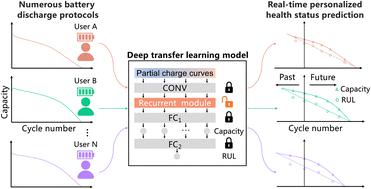当前位置:
X-MOL 学术
›
Energy Environ. Sci.
›
论文详情
Our official English website, www.x-mol.net, welcomes your feedback! (Note: you will need to create a separate account there.)
Real-time personalized health status prediction of lithium-ion batteries using deep transfer learning
Energy & Environmental Science ( IF 32.5 ) Pub Date : 2022-07-30 , DOI: 10.1039/d2ee01676a Guijun Ma 1 , Songpei Xu 2 , Benben Jiang 3 , Cheng Cheng 2 , Xin Yang 4 , Yue Shen 5 , Tao Yang 6 , Yunhui Huang 5 , Han Ding 1 , Ye Yuan 2
Energy & Environmental Science ( IF 32.5 ) Pub Date : 2022-07-30 , DOI: 10.1039/d2ee01676a Guijun Ma 1 , Songpei Xu 2 , Benben Jiang 3 , Cheng Cheng 2 , Xin Yang 4 , Yue Shen 5 , Tao Yang 6 , Yunhui Huang 5 , Han Ding 1 , Ye Yuan 2
Affiliation

|
Real-time and personalized lithium-ion battery health management is conducive to safety improvement for end-users. However, personalized prognostic of the battery health status is still challenging due to diverse usage interests, dynamic operational patterns and limited historical data. We generate a comprehensive dataset consisting of 77 commercial cells (77 discharge protocols) with over 140 000 charge–discharge cycles—the largest dataset to our knowledge of its kind, and develop a transfer learning framework to realize real-time personalized health status prediction for unseen battery discharge protocols, at any charge–discharge cycle. Our method can achieve mean testing errors of 0.176% and 8.72% for capacity estimation and remaining useful life (RUL) prediction, respectively. Additionally, the proposed framework can leverage the knowledge from two other well-known battery datasets, with a variety of charge configurations and a different battery chemistry respectively, to reliably estimate the capacity (0.328%/0.193%) and predict the RUL (9.80%/9.90%) of our cells. This study allows end users to tailor battery consumption plans and motivates manufacturers to improve battery designs.
中文翻译:

使用深度迁移学习对锂离子电池进行实时个性化健康状态预测
实时、个性化的锂离子电池健康管理,有利于提升终端用户的安全性。然而,由于不同的使用兴趣、动态的操作模式和有限的历史数据,电池健康状态的个性化预测仍然具有挑战性。我们生成了一个由 77 个商业电池(77 个放电协议)组成的综合数据集,具有超过 140 000 个充电-放电循环——这是我们所知道的同类数据中最大的数据集,并开发了一个迁移学习框架来实现实时个性化健康状态预测在任何充电-放电循环中,看不见的电池放电协议。我们的方法可以实现容量估计和剩余使用寿命(RUL)预测的平均测试误差分别为 0.176% 和 8.72%。此外,所提出的框架可以利用来自其他两个著名电池数据集的知识,分别具有各种充电配置和不同的电池化学成分,以可靠地估计容量 (0.328%/0.193%) 并预测 RUL (9.80%/9.90 %) 我们的细胞。这项研究允许最终用户定制电池消耗计划,并激励制造商改进电池设计。
更新日期:2022-07-30
中文翻译:

使用深度迁移学习对锂离子电池进行实时个性化健康状态预测
实时、个性化的锂离子电池健康管理,有利于提升终端用户的安全性。然而,由于不同的使用兴趣、动态的操作模式和有限的历史数据,电池健康状态的个性化预测仍然具有挑战性。我们生成了一个由 77 个商业电池(77 个放电协议)组成的综合数据集,具有超过 140 000 个充电-放电循环——这是我们所知道的同类数据中最大的数据集,并开发了一个迁移学习框架来实现实时个性化健康状态预测在任何充电-放电循环中,看不见的电池放电协议。我们的方法可以实现容量估计和剩余使用寿命(RUL)预测的平均测试误差分别为 0.176% 和 8.72%。此外,所提出的框架可以利用来自其他两个著名电池数据集的知识,分别具有各种充电配置和不同的电池化学成分,以可靠地估计容量 (0.328%/0.193%) 并预测 RUL (9.80%/9.90 %) 我们的细胞。这项研究允许最终用户定制电池消耗计划,并激励制造商改进电池设计。



























 京公网安备 11010802027423号
京公网安备 11010802027423号